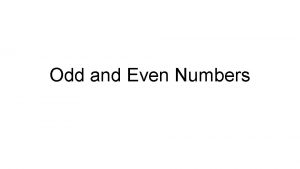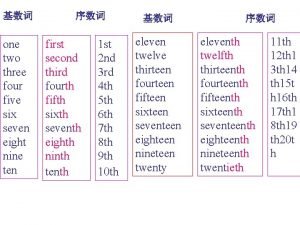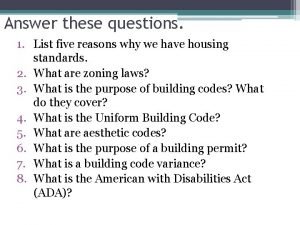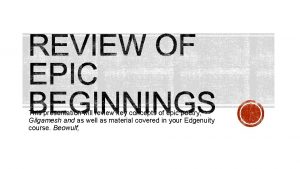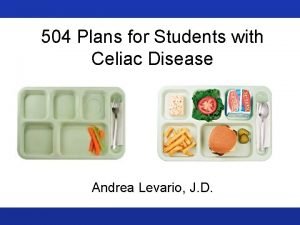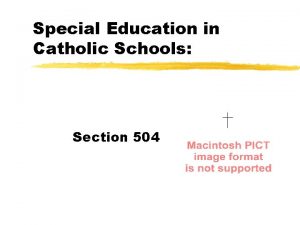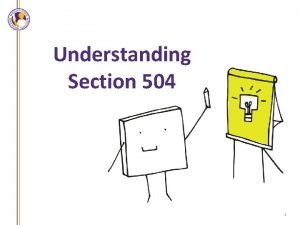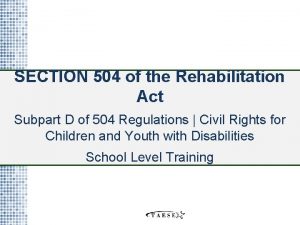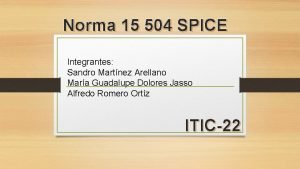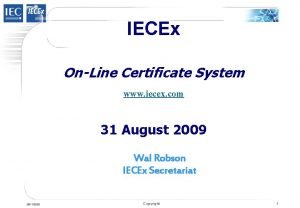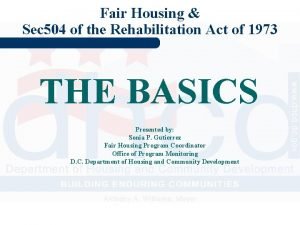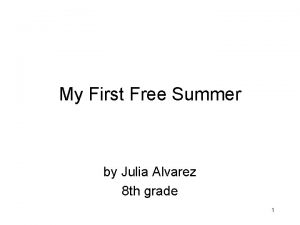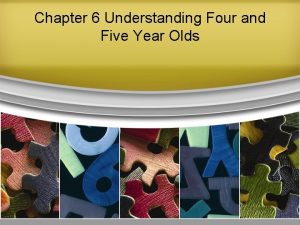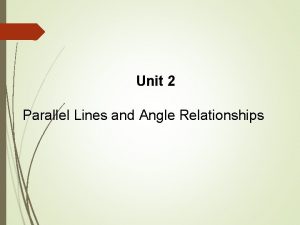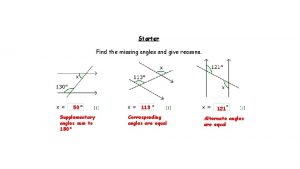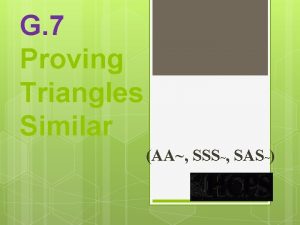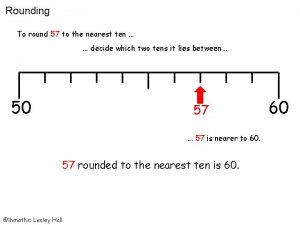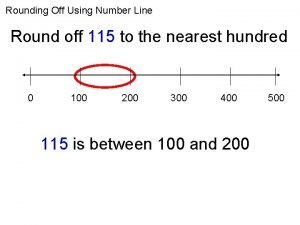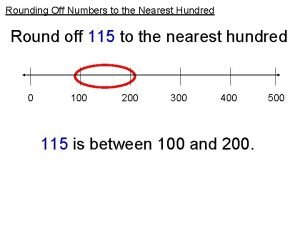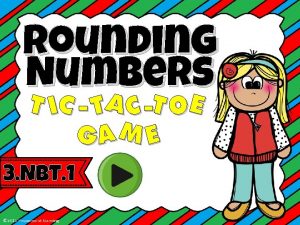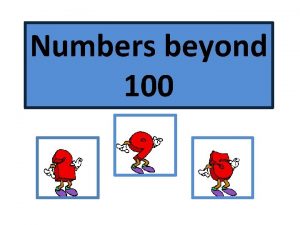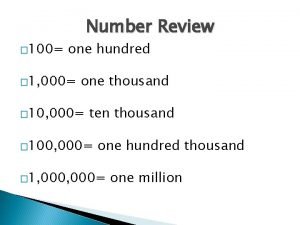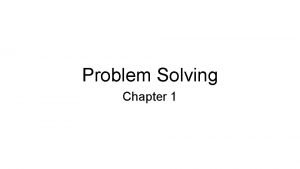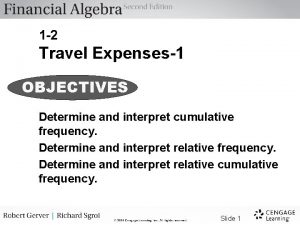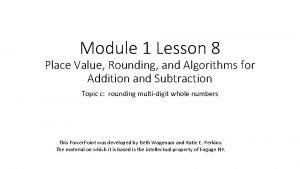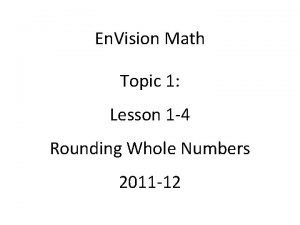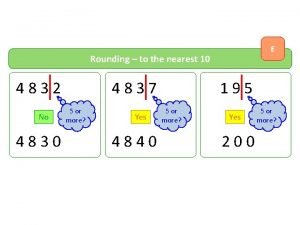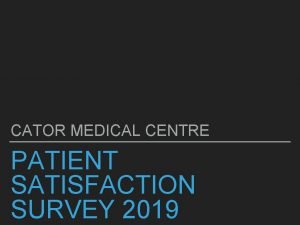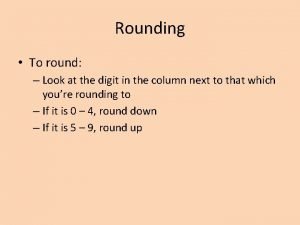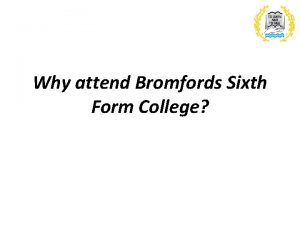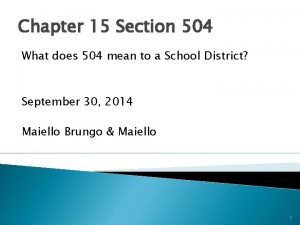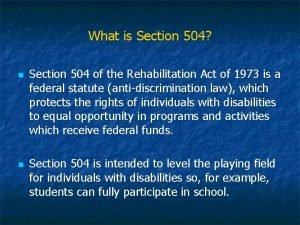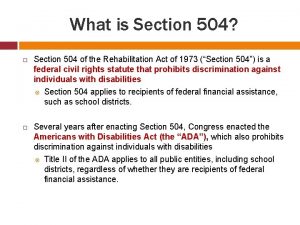504 Five Hundred and Four Reasons to Attend







































































































- Slides: 103

504: Five Hundred and Four Reasons to Attend this Session (Minus a Few Hundred) Richard Mc. Coy Dixon R 1 Middle School Counselor & South Central MSCA President

CAVEAT I am a School Counselor, not a Lawyer, Politician, or Clairvoyant. What I share is based on personal experience and research.

1991 -1995 2009 -2011 1996 -1997 -2012 -Present


Today’s Agenda v. How does a 504 work? v. A (short) History Lesson v. IDEA & 504 s: Kissing Cousins or Distant Relatives? v. What is our responsibility as Counselors? v. Share Experiences v. Writing Useful Accommodations v. Where We Stand Under the Law v. What is MSCA’s stance on the counselor’s role regarding 504 s?

My first REAL experience An 8 th grade child is no longer in Special Education. He now has a 504 as he still is in need of services which a 504 can provide. When he enters high school next year, Mom would like child to go to the Sp. Ed room to cool down as he needs a cool down place from time to time and it’s where he would feel most comfortable.

Question: Can a child with a 504 go to a Special Education room for a place to cool down? Turn to a Shoulder Partner and discuss this for 30 seconds.

How do I find out?

My first REAL experience

My first REAL experience

My first REAL experience

My first REAL experience

My first REAL experience

My first REAL experience


? ! s? 4 0 5 You may feel like this when you hear the phrase “ 504”.

Or This…

My Office

Today’s Agenda v. How does a 504 work? v. A (short) History Lesson v. IDEA & 504 s: Kissing Cousins or Distant Relatives? v. What is our responsibility as Counselors? v. Share Experiences v. Writing Useful Accommodations v. Where We Stand Under the Law v. What is MSCA’s stance on the counselor’s role regarding 504 s?

Leveling the Playing Field

Section 504 of the Rehabilitation Act / 1973 • A federal Anti Discrimination Law. • Protects ALL people with a disability that impairs one or more major life activity (learning is one). • Prohibits discrimination in ANY program that receives federal dollars. • Provides accommodations to remove discriminatory barriers. • In education, a “ 504 Plan” removes barriers to learning and opportunities.

Individuals with Disabilities Education Act / 1975 • A federal Education Law. • For students with at least one of 13 qualifying categories of disability. • Who ALSO need specialized support and instruction to benefit from education. • Provides a “special education” plan: “IEP” specialized instruction related supportive services • “IEP” must be individualized to meet a student’s unique needs.

The Americans with Disabilities Act / 1990 • ADA provided additional protection in combination with actions brought under Section 504. Reasonable accommodations are required for eligible students with a disability to perform essential functions of the job. • ADA protections apply to nonsectarian private schools, but not to organization or private schools, or entities controlled by religious organization; • Applies to any part of the special education program that may be community-based and involve job training/placement. Also applies to Childcare centers and recreation programs.

The ADA Amendments Act of 2008 • The ADAAA retains the ADA’s definition of disability as a physical or mental impairment that substantially limits one or more life activities; a record of such impairment; or being regarded as having such impairment. However, it clarifies and expands the definition’s meaning and application in the following ways

The Americans with Disabilities Act / 1990 A civil rights law to prohibit discrimination solely on the basis of disability in employment, public services, and accommodations. Protects: Any individual with a disability who: (1) has a physical or mental impairment that substantially limits one or more life activities; or (2) has a record of such impairment; or (3) is regarded as having such an impairment.

504: Evaluation • Who should be part of the Evaluation? – A team of individual knowledgeable about the student, evaluation procedures, and service options • Teachers • Parents • Physicians (medical diagnosis alone is not sufficient)

504: Evaluation 1. Does the student have a physical or mental impairment (disability)?

504: Defining Disability • Physical: Physiological disorder or condition, cosmetic disfigurement, or anatomical loss affecting one or more body systems • Mental: A mental or psychological disorder, such as Intellectual Disability, Organic Brain Disorder, Emotional or Mental Illness • TEMPORARY: Something that will affect student for less than 6 months does not qualify

504: Evaluation 1. Does the student have a physical or mental impairment? 2. Does the Identified disability impact a major life activity?

504: Major Life Activity • Major life activity: These can include learning, reading, thinking, writing and concentrating. A child’s disability may substantially limit one or more major life activities. • The ADAAA of 2008 opened this up to a much broader scale by congress to expand our idea of disability and a major life activity with two Non exhaustive lists.

504: Major Life Activity The next two slides are from Dixon’s 504 Plan worksheets.

504: Major Life Activity

504: Evaluation 1. Does the student have a physical or mental impairment? 2. Does the Identified disability impact a major life activity? 3. Does the physical or mental impairment substantially limit the student’s ability to engage in a major life activity?

504: Substantially Limit • “…in this ADAAA (Americans with Disabilities Act Amendments Act of 2008) era, an individual’s impairment must limit one or more major life activities in a substan tial manner, but need not limit that major life activity in a severely restrictive fashion, in order for the impairment to qualify as an ADA disability. ” Definition of Disability Under the ADA: A Practical Overview and Update

504: Substantially Limit • “The Term ‘substantially limits’ shall be interpreted without regard to the ameliorative effects of mitigating measures. ” United States Department of Education Office of Civil Rights Q&A on the ADA Amendments Act of 2008


Let’s Ask Google • Ameliorative: Properly used to mean `improve‘ • Mitigating Measure: A measure to make something less severe, serious, or painful. • Example: A child who takes medicine to manage ADHD can now qualify for a 504 plan.

Today’s Agenda v. How does a 504 work? v. A (short) History Lesson v. IDEA & 504 s: Kissing Cousins or Distant Relatives? v. What is our responsibility as Counselors? v. Share Experiences v. Writing Useful Accommodations v. Where We Stand Under the Law v. What is MSCA’s stance on the counselor’s role regarding 504 s?

How do the ADA, 504, and IDEA relate to each other? The Americans with Disabilities Act of 1990 (ADA), the Individuals with Disabilities Education Act (IDEA), and Section 504 of the Rehabilitation Act of 1973 represent three attempts to improve the living conditions of those with disabilities, to ensure equal access, and to promote inclusion. Go to: http: //www. dredf. org/advocacy/comparison. html For a comparison of these laws.

Comparing IDEA & 504 IDEA 504 Basic Description A blueprint or plan for a child’s special education experience at school. A blueprint or plan for how a child will have equal access to learning at school. What It Does Provides individualized special education and related services to meet the unique needs of the child. These services are provided at no cost to parents. Provides services and changes to the learning environment to meet the needs of the child as adequately as other students. As with IEPs, a 504 plan is provided at no cost to parents https: //www. understood. org/en/school learning/special services/504 plan/the difference between ieps and 504 plans

Comparing IDEA & 504 IDEA What Law Applies 504 Section 504 of the The Individuals with Rehabilitation Act of 1973 & Disabilities This is a federal civil rights law Education Act to stop discrimination against (IDEA) people with disabilities. The ADA Amendments Act of This is a federal 2008 special education law for children with This Act broadened the definition of Disability disabilities.

Comparing IDEA & 504 IDEA To get an IEP, there are two requirements: 1. A child has one or more of the 13 specific disabilities listed in Who Is IDEA. Learning and attention Eligible issues may qualify. 2. The disability must affect the child’s educational performance and/or ability to learn and benefit from the general education curriculum. 504 To get a 504 plan, there are two requirements: 1. A child has any disability, which can include many learning or attention issues. 2. The disability must substantially limit a “major life activity”. Section 504 has a broader definition of a disability than IDEA. That’s why a child who doesn’t qualify for an IEP might still be able to get a 504 plan.

Comparing IDEA & 504 IDEA There are strict legal requirements about who participates. An IEP is created by an IEP team that must include: • The child’s parent • At least one of the child’s general education teachers Who Creates the • At least one special education Program/Plan teacher • School psychologist or other specialist who can interpret evaluation results • A district representative with authority over special education services 504 The rules about who’s on the 504 team are less specific than they are for an IEP. A 504 plan is created by a team of people who are familiar with the child and who understand the evaluation data and special services options. This might include: • The child’s parent • General and special education teachers • The school principal

Comparing IDEA & 504 IDEA There are strict legal requirements about who participates. An IEP is created by an IEP team that must include: • The child’s parent • At least one of the child’s general education teachers Who Creates the • At least one special education Program/Plan teacher • School psychologist or other specialist who can interpret evaluation results • A district representative with authority over special education services 504 The rules about who’s on the 504 team are less specific than they are for an IEP. A 504 plan is created by a team of people who are familiar with the child and who understand the evaluation data and special services options. This might include: • The child’s parent • General and special education teachers • The school principal

Quiz Time!

Who did we NOT see on that 504 list? A. Captain America B. King Leonidas and the Brave 300 C. Santa Claus D. The School Counselor E. All of the Above

What do you win? ? ?

Comparing IDEA & 504 IDEA What's in the Program/ Plan • The child’s present levels of academic and functional performance • Annual education goals • The services the child will get • The timing of services • Any accommodations—changes to the child’s learning environment • Any modifications—changes to what the child is expected to learn or know • Standardized tests • Included in general education classes and school activities 504 There is no standard 504 plan. A 504 plan generally includes the following: • Specific accommodations, supports or services for the child • Names of who will provide each service • Name of the person responsible for ensuring the plan is implemented

Comparing IDEA & 504 Parent Notice IDEA 504 To make changes to a child’s services or placement, it has to notify parents in writing before the change. This is called prior written notice. Notice is also required for any IEP meetings and evaluations. Parents also have “stay put” rights to keep services in place while there’s a dispute. The school must notify parents about evaluation or a “significant change” in placement. Notice doesn’t have to be in writing, but most schools do so anyway.

Comparing IDEA & 504 Parent Consent IDEA 504 A parent must consent in writing for the school to evaluate a child. Parents must also consent in writing before the school can provide services in an IEP. A parent’s consent is required for the school district to evaluate a child.

Comparing IDEA & 504 IDEA The IEP team must review How Often the IEP at least once a year. The student must be It’s Reviewed reevaluated every three and Revised years to determine whether services are still needed. 504 The rules vary by state. Generally, a 504 plan is reviewed each year and a reevaluation is done every three years or when needed.

Comparing IDEA & 504 Funding/ Costs IDEA 504 Students receive these services at no charge. States receive additional funding for eligible students. Students receive these services at no charge. States do not receive extra funding for eligible students. But the federal government can take funding away from programs (including schools) that don’t comply. IDEA funds can’t be used to serve students with 504 plans.


504 in a Nutshell Section 504 covers disabled persons in programs receiving federal funds: - public schools explicitly, but also - publicly-funded programs such as day care programs, - after-school programs and even some private schools To be eligible for services and to ensure a Free and Appropriate Public Education (FAPE) and protection against discrimination under Section 504, a student must have a physical or mental impairment that substantially limits one or more major life activities. [29 U. S. C. 706 (8)(B)]

Today’s Agenda v. How does a 504 work? v. A (short) History Lesson v. IDEA & 504 s: Kissing Cousins or Distant Relatives? v. What is our responsibility as Counselors? v. Share Experiences v. Writing Useful Accommodations v. Where We Stand Under the Law v. What is MSCA’s stance on the counselor’s role regarding 504 s?

Your Experiences 504

Your Experiences

Today’s Agenda v. How does a 504 work? v. A (short) History Lesson v. IDEA & 504 s: Kissing Cousins or Distant Relatives? v. What is our responsibility as Counselors? v. Share Experiences v. Writing Useful Accommodations v. Where We Stand Under the Law v. What is MSCA’s stance on the counselor’s role regarding 504 s?

Accommodations: Attention & Focus • Preferential Seating • Provide Refocusing Prompts: – Physical: Place hand gently on shoulder or desk – Verbal: Private, Prearranged signal words – Non Verbal: Hand signal after making eye contact • Allow use of “fidget” object • Use different colored markers/print • Headphones or earplugs during seat work

Accommodations • All students who meet criteria under the 504 definition of a person with a disability are protected under the law. • Students who require accommodations to access regular education program (i. e. . To have a level playing field) are entitled to an accommodation plan

Accommodations: Attention & Focus • Use a marker/book mark to go under the text to hold attention when reading • Structure materials to enhance attention & focus: – Block or Mask page – Highlight/Underline/Circle important parts – Enlarge Font Size – Limit Material on Each Page

Accommodations: Work Production & Output • Class Assignments: – Check for Clarity Often – Provide samples and models of “standard” and “exemplary” work – Reduce copying from the board with photocopy of notes – Allow student to stretch after accomplishing a task – Use a timer and reward student’s ability to beat the clock during short work periods

Accommodations: Work Production & Output • Homework: – Provide a second set of text books for home use – Allow student to work for a predetermined number of minutes and then stop (with parental supervision) – Use a student planner and require daily use – Allow student to email homework – Visually post assignments – Allow for extra time to turn in assignments – Reduce homework load (i. e. odd or even problems)

Accommodations: Work Production & Output • Both Classwork & Homework: – Break assignments into smaller parts – Extended time – Do not penalize for spelling/mechanical errors on tests intended to measure other content/skills – Differentiate assignments – Increase communication with parents/guardians

Accommodations: Planning & Organizing • Use a 3 ring binder with subject dividers and pocket folders (ADD/ADHD ) • Use a planner • Provide handouts that are 3 hole punched to put in binder OR have a 3 hole punch to use • Make a checklist of materials for activities • Color code materials • Use a clipboard to anchor papers • Provide time to organize materials

Accommodations: Time Awareness & Management Require consistent use of calendar/planner Check that assignments are recorded Assign a peer helper to double check planner Help with developing a timeline for assignments Display clear schedules Use pictorial calendar for younger students & refer to them throughout the day • Provide advanced notice to parents about important assignments/due dates • • •

Accommodations: Listening, Recall, and Following Directions Repeat Directions Simplify Complex Instructions Use Study Guides or Partially Written Outlines Check for Understanding/ask students to repeat/paraphrase directions • Pair verbal instructions with written • Provide written/pictorial checklists, task cards, and reminders of expectations for independent work activities • •

Accommodations: Test-Taking Teacher Proximity Have test direction read aloud Have test items/answer choices read aloud Extend time Multiple sessions Different location Allow for oral answers Allow supplemental tools (spell checker, calculator, multiplication table/chart) • Provide graph paper for math related tasks • •

Accommodations: Behavior & Self-Regulation Increase monitoring and cueing during transitions Redirect student when signs of frustration appear Increase positive feedback Allow students to use a “fidget” Provide information ahead of time whenever there are changes in the routine • Allow alternative seating/work area • Establish private signals • • •

Accommodations: Expressive Language • Provide extra “wait time” before responses (at least 5 seconds) • Allow alternative options for oral presentations • Give cues to students when you are going to call on them in class • Provide an opportunity to discuss answers with a partner before a whole class response

Accommodations: Reading • Use graphic organizers to aid recall • Audio recordings of the book • Supplemental materials at an easier reading level • Large print or magnifying device • Pair with a Reading Buddy

Accommodations: Reading • Allow student to be Reading Buddy to a younger grade student • Preview information prior to reading • Pre teach challenging vocabulary • Use marker/book mark to track text • Photocopy pages of text to highlight • Permit students to read aloud quietly

Accommodations: Writing Use clipboard to anchor papers Allow use of computer to type Use college ruled or wide ruled paper Provide photocopy instead of requiring writing from the board • Sentence Starters • •

Accommodations: Writing • Provide desk copies of frequently misspelled words • Stress accuracy/quality over volume • Grade content and spelling/mechanics separately • Enlarge space on tests to write • Alphabet strips or cursive charts on desk • Allow sufficient time to write

Accommodations: Math • Use a calculator • Desk references (multiplication tables, formulas, etc. ) • Reduce problems assigned • Cut up page into strips or rows to be completed • Provide steps and procedures to multistep problems with a “desk copy” • Graph paper to keep numbers organized • Additional samples

Accommodations: Other Possible Accommodations • Access: – Special Transportation/Equipment/Access – Auditory amplification or interpreter • Scheduling: – Preferential scheduling to optimize attention level – Adjust class schedules to address individual issues • Physical/Medical needs: – Rest Periods – Permission for bathroom breaks/water/snacks – Extended time for missing work without penalty

Services, Accommodations and Modifications EXAMPLE: Accommodations for children with diabetes might include: • Ability to leave class when needed • Free access to food and water • Preferential seating • Administration of health protocols in class • Additional time to complete assignments without penalty • Ability to make up work missed to fulfill health related needs or doctor’s appointments without penalty.

Today’s Agenda v. How does a 504 work? v. A (short) History Lesson v. IDEA & 504 s: Kissing Cousins or Distant Relatives? v. What is our responsibility as Counselors? v. Share Experiences v. Writing Useful Accommodations v. Where We Stand Under the Law v. What is MSCA’s stance on the counselor’s role regarding 504 s?

504 & the LAW • Section 504 protects persons with disabilities from discrimination in programs receiving federal funds; ensures persons with disabilities Equal Access to such programs; and requires programs to make Reasonable Accommodations, where necessary, to provide such access.

504 & the LAW • Unlike IDEA, Section 504 provides for services to meet the individual educational needs of students with disabilities as adequately as the needs of nondisabled students.

Loving Parents “But my child…”

504 & the LAW “The IDEA guarantees an ‘appropriate’ education, ‘not one that provides everything that might be thought desirable by loving parents. ” • Weixel v. Board of Education of the City of New York (2000) “Section 504 does not require a public school district to provide students with disabilities with potential maximizing education, only reasonable accommodations…” • J. D. v. Pawlet School District (2000)

Tips: Conflict Prep “just in case” DOCUMENTATION RULE OF THUMB: “If it was never written, it was never said and will never be done. ” • Know your Districts grievance policy • Section 504 prohibits discrimination on the basis of disability in any program or activity receiving Federal financial assistance. http: //www. hhs. gov/ocr/civilrights/clearance/exampleofasection 504 grievanceprocedure. html

Today’s Agenda v. How does a 504 work? v. A (short) History Lesson v. IDEA & 504 s: Kissing Cousins or Distant Relatives? v. What is our responsibility as Counselors? v. Share Experiences v. Writing Useful Accommodations v. Where We Stand Under the Law v. What is MSCA’s stance on the counselor’s role regarding 504 s?


MSCA’s Position The Professional School Counselor’s Role in the 504 Process A Position Paper of the Missouri School Counselor Association

MSCA’s Position Missouri School Counselor Association (MSCA) strongly supports the implementation of an effective 504 process that helps remove barriers to student learning and achievement. School counselors have a meaningful role in helping address student needs and are an integral member of a student’s 504 team when that student falls under their caseload.

MSCA’s Position School counselors may be the first line of contact from a parent to report a mental health or other disorder. School counselors can also be the initiator of an intervention for a struggling student. School counselors may be a part of staffings and conferences when warranted and are regarded as knowledgeable, educated professionals able to share insight on particular students, as well as resources and interventions.

MSCA’s Position: School counselors have a responsibility to develop and provide a comprehensive guidance and counseling program to all students, including students with disabilities. The initiating, writing, and management of the 504 process falls under the non guidance category of special programs and services according to DESE’s Missouri Comprehensive Guidance and Counseling Program.

MSCA’s Position: Furthermore, the American School Counselor Association states in their position statement on disabilities, that the writing, coordinating and supervision related to a 504 falls under inappropriate duties of a professional school counselor. Placing the school counselor in the role of the 504 coordinator or case manager has a detrimental effect on their ability to provide a comprehensive guidance and counseling program.

MSCA’s Position: The school counselor is an advocate for the student and an essential member of the 504 team. The strengths the school counselor brings as an effective communicator, collaborator, problem solver, interventionist, liaison, and mental health specialist creates a unique role for them on the 504 team. The conflict the 504 coordinator/case manager duties creates for school counselors include but is not limited to:

MSCA’s Position: 1. lack of professional training in 504 legalities and paperwork, 2. dual relationships, 3. time demand, 4. counselors are mental health professionals not special education professionals, 5. superior role conflict with teachers, 6. possibly adversarial role with parents instead of advocacy, and 7. creates a barrier to availability to provide responsive services.

MSCA’s Position: When time is taken away from a school counselor’s ability to provide direct student services and instead perform barriers to implementation duties, a counselor’s ability to make a positive impact on student outcomes suffers.

MSCA’s Position: MSCA strongly believes that school counselors should not be responsible for the development, implementation, and monitoring of any 504’s. MSCA, in agreement with ASCA and DESE, supports the position of removing case management responsibilities from the assigned duties of school counselors.

MSCA’s Position: The duties involved in the 504 process create significant barriers to implementation of a comprehensive guidance and counseling program as counselors are trained and devoted to provide, in order to address all students’ emotional and academic needs.

Applause is Appropriate

What’s our Next Step? • What do we say when our administrators and school boards say, “Whose responsibility is it, then, to do the 504 s in our district if it isn’t the Counselor’s job? ”

Concluding Thoughts NO MATTER WHAT!

THANK YOU FOR COMING!


Office for Civil Rights Kansas City Office for Civil Rights Washington, DC Office U. S. Department of Health and 200 Independence Ave SW, Human Services Washington, DC 20201 601 East 12 th Street Room 353 Phone: (800) 368 1019 Kansas City, MO 64106 Customer Response Center: (800) 368 1019 Fax: (202) 619 3818 TDD: (800) 537 7697 Email: ocrmail@hhs. gov

References 1. Educator’s Quick Reference for Section 504: http: //www. esc 20. net/users/0040/docs/Section%20504/New%20 Adm inistrator's%20 Guide%20 to%20 Section%20504. pdf 2. The Difference Between IEPs and 504 Plans: Comparison chart. ttps: //www. understood. org/en/school learning/special services/504 plan/the difference between ieps and 504 plans 3. Section 504 of the Rehabilitation Act, Karen Norlander, laminated tri fold guide 4. Section 504: Classroom Accommodations, Sandra Rief, laminated tri fold guide 5. Health and Human Services 504 Grievance Policy, http: //www. hhs. gov/ocr/civilrights/clearance/exampleofasection 504 g rievanceprocedure. html 6. MSCA’s 504 Position Paper http: //moschoolcounselor. org/files/2015/05/504 position paper. pdf

References 1. Frequently Asked Questions and Answers, http: //www. pearsallisd. org/User. Files/Server_777750/Fi le/Administration/Special%20 Programs/04/504%20 FAQ. pdf 2. A Parent and Teacher Guide to Section 504: FAQ http: //www. fldoe. org/core/fileparse. php/7690/urlt/0070055 504 bro. pdf 3. US Department of Education, http: //www 2. ed. gov/about/offices/list/ocr/qa disability. html 4. Help for College Students with Disabilities from Wrightslaw. com http: //www. wrightslaw. com/flyers/college. 504. pdf 5. Definition of Disability Under the ADA: A Practical Overview and Update, http: //www. hrtips. org/article_1. cfm? b_id=27
 One two three four five
One two three four five One two three four five six to hundred
One two three four five six to hundred One two three four five six to hundred
One two three four five six to hundred Three four five six seven eight nine ten
Three four five six seven eight nine ten What spooked jem on the night of the radley
What spooked jem on the night of the radley Five hundred thousand
Five hundred thousand If the acceleration lane is short, you will need
If the acceleration lane is short, you will need List five reasons
List five reasons Two hundred fifty thousand in numbers
Two hundred fifty thousand in numbers Epic poem
Epic poem Show, attend and tell
Show, attend and tell Staubgrenzwert
Staubgrenzwert Idea vs 504
Idea vs 504 La factorización prima de 504 es
La factorización prima de 504 es 504 plan oklahoma
504 plan oklahoma Celiac 504 plan
Celiac 504 plan 504 plan catholic schools
504 plan catholic schools Single family housing section 504 repair pilot program
Single family housing section 504 repair pilot program Section 504 home repair program
Section 504 home repair program Html 504
Html 504 Manifestation determination meeting agenda
Manifestation determination meeting agenda Section 504
Section 504 Bridge loan
Bridge loan Section 504
Section 504 Norma 504
Norma 504 Www.iecex.com
Www.iecex.com Sec 504
Sec 504 5 elements and 5 senses
5 elements and 5 senses Act 1 of romeo and juliet in modern english
Act 1 of romeo and juliet in modern english Want 2. ve 3. hali
Want 2. ve 3. hali Tes laitues naissent-elles oui mes laitues naissent
Tes laitues naissent-elles oui mes laitues naissent Formal reply to accept invitation
Formal reply to accept invitation Un grand amour m'attend
Un grand amour m'attend My first free summer julia alvarez pdf
My first free summer julia alvarez pdf Request to attend meeting sample
Request to attend meeting sample Un grand amour m'attend
Un grand amour m'attend Understanding four and five year olds
Understanding four and five year olds Shape with one side
Shape with one side The sounding cataract haunted me
The sounding cataract haunted me Five of five
Five of five Macbeth act five scene one
Macbeth act five scene one Five six seven eight
Five six seven eight Zero one two three four five
Zero one two three four five La
La It's twenty five to twelve
It's twenty five to twelve Worksheet on a day with nandu
Worksheet on a day with nandu 4 eyes skin assessment tool
4 eyes skin assessment tool A hundred agonies in black and white analysis
A hundred agonies in black and white analysis War photographer poem annotated
War photographer poem annotated Place value of 300
Place value of 300 Solutions slop in trays
Solutions slop in trays Geometry statements and reasons
Geometry statements and reasons Geometry unit 1 proof parallel and perpendicular lines
Geometry unit 1 proof parallel and perpendicular lines God gold glory drawing
God gold glory drawing Mathematical proof
Mathematical proof Geometry statements and reasons
Geometry statements and reasons Why was a merger between singapore and malaya proposed
Why was a merger between singapore and malaya proposed Segment and angle proof reasons scavenger hunt
Segment and angle proof reasons scavenger hunt Angles reasons
Angles reasons Congruence statement and reason
Congruence statement and reason Similar image
Similar image Round 548 to the nearest hundred
Round 548 to the nearest hundred 625 to the nearest ten
625 to the nearest ten 57 to nearest 10
57 to nearest 10 Round 630 to the nearest hundred
Round 630 to the nearest hundred 650 rounded to the nearest 100
650 rounded to the nearest 100 Board ga,e
Board ga,e Five or above give it a shove
Five or above give it a shove Aureliano segundo
Aureliano segundo The value of words
The value of words Numbers beyond 100
Numbers beyond 100 No way. the hundred is there
No way. the hundred is there Decimals ones tens hundreds
Decimals ones tens hundreds Hundred thousand million billion trillion
Hundred thousand million billion trillion 517 rounded to the nearest hundred
517 rounded to the nearest hundred Chafford hundred medical centre
Chafford hundred medical centre Hundred heartbeat club
Hundred heartbeat club Mark murphy hundred percenters
Mark murphy hundred percenters What is a hundred thousand
What is a hundred thousand Hundred flowers campaign
Hundred flowers campaign One in a hundred thousand
One in a hundred thousand What is 268 rounded to the nearest hundred
What is 268 rounded to the nearest hundred 645 rounded to the nearest ten
645 rounded to the nearest ten Round 647 to the nearest hundred
Round 647 to the nearest hundred 250 nearest 100
250 nearest 100 757 to the nearest ten
757 to the nearest ten Explain why the bagged and loose toothpicks
Explain why the bagged and loose toothpicks Hundred thousand
Hundred thousand 10 thousands = hundreds
10 thousands = hundreds Hundred flowers campaign
Hundred flowers campaign What term means per hundred
What term means per hundred Round 683 492 to the nearest hundred thousand
Round 683 492 to the nearest hundred thousand Nrich coded hundred square
Nrich coded hundred square Hundred handed giants greek mythology
Hundred handed giants greek mythology 449 019 rounded to the nearest hundred thousand is
449 019 rounded to the nearest hundred thousand is 295 rounded to the nearest ten
295 rounded to the nearest ten 34728 rounded off to the nearest thousand
34728 rounded off to the nearest thousand Chafford hundred econsult
Chafford hundred econsult Narayan mandayam
Narayan mandayam Round off 37
Round off 37 Gaea and uranus family tree
Gaea and uranus family tree One hundred years word
One hundred years word Kanga gives piglet a bath
Kanga gives piglet a bath Round to it
Round to it

